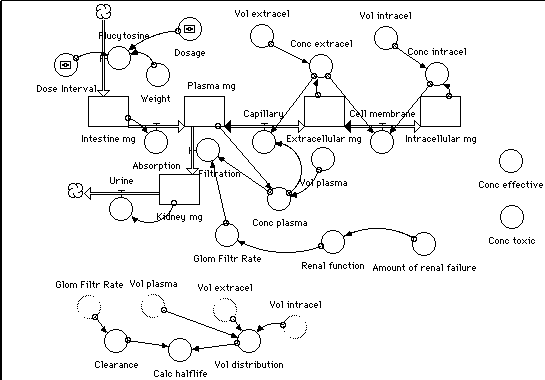Algorithm
How do we model this problem?
Using STELLA
We decided to use STELLA to build the inital model because both of us were familiar with it and we felt that the multicompartment model would be easier to handle graphically. STELLA uses a graphical interface to assemble equations that approximate the behavior of the drug over time. The drug moves from one form, or stock, to another through flows. The pharmacokinetics research that we did allowed us to define these flows to represent the way penicillin actually moves through the body. Below is a graphic of the STELLA model.

Explaining the Model
Initially the flucytosine is taken orally and its dosage and frequency can vary. Some of this drug is then absorbed into the plasma whose movement is controlled by the absorption rate. The flucytosine can then be filtered into the kidneys whose movement is controlled by the glomerular filtration rate. This rate is determined by the amount of renal failure. While in the kidneys, the drug can be affected by renal failure on the second day. It is eliminated from the kidneys through urine. From the plasma, the flucytosine can also move to the extracellular spaces through the capillaries. This movement is bidirectional which means that some of the drug in the extracellular spaces can also travel back to the plasma through the capillaries as well. From the extracellular spaces, the drug can move through the cell membranes into the intracellular spaces. This movement is also bidirectional meaning that the drug can also move in the reverse way as well. The concentration of flucytosine in the plasma is compared to the toxic and effective concentrations to determine whether the drug is therepeutic or fatal.
[Flucytosine and You] [Application] [Algorithm] [Architecture] [Run the Model]
[Extensions] [Sources and Acknowledgements] [ Glossary of terms] [Shodor home page]

